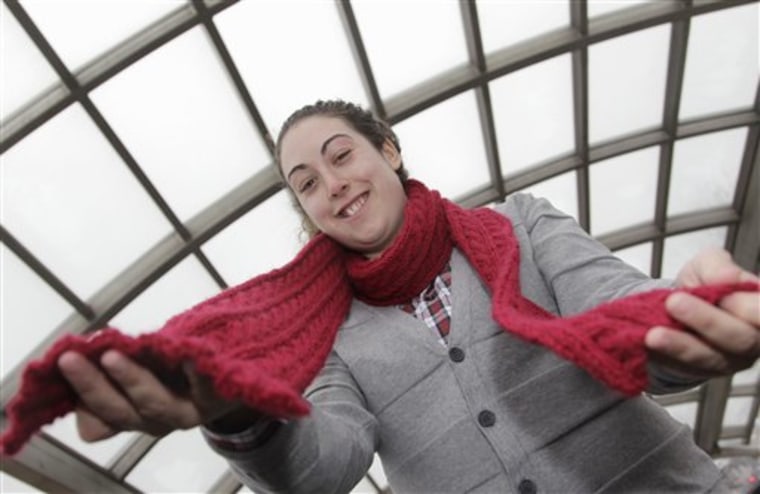Soon, the red scarves will arrive at colleges around the country. For many of the former foster children unwrapping one on Valentine's Day, it will be their first new or handmade piece of clothing.
That was true for Amanda Babine, who spent her youth bouncing from foster home to foster home. One year she moved 11 times.
So she looked forward to having something new each Valentine's Day in college, and even bought red gloves and a red hat to coordinate.
"It feels very personal, someone is taking the time and effort to make you something," said Babine, now 24 and living in Washington, D.C.
In all, some 2,500 Red Scarf Project packages will be sent this Valentine's Day through the annual project run by the Orphan Foundation of America. The recipients are all current or former foster children enrolled in college who receive scholarships through the foundation.
The group also acts as a support system to the students — since they are largely on their own — by being in regular contact through phone calls, e-mails and care packages. But the Red Scarf project has become the group's signature effort, with the scarves outshining the candy, gift cards and school supplies that fill the Valentine's Day packages.
"You realized it wasn't just a bunch of stuff put in a box. It was more than that. It made you feel appreciated and know that there were people that thought about you," said Sarah Lucas-Melo, who has three scarves she received during her time at State University of New York College at Geneseo.
Scarves come in varying styles — elaborate cables, striped scarves adorned with fringe or simple patterns with the most basic of stitches — from around the country and world. They're all made by knitters who volunteer their time and hobby anonymously.
The project has grown as the trend of knitting for charity spreads. There are projects to make clothing for children, say, or hats for cancer patients. Knitters connect through networking sites and blogs to get support quickly.
In the Red Scarf project's first year, knitters sent in about 2,500 to 3,000 scarves. The second year — after word spread — 15,000 came in.
The third year, the Orphan Foundation set a limit of five scarves per knitter so they wouldn't have more scarves than they could handle.

Kathryn Camosy said she doesn't have much money to give, so she donates through knitting. She has knit one red scarf each of the last three years, working little by little over several months to send the scarf in each winter.
"I think it means more when you actually physically do something for someone versus drop a check in the mail," said Camosy, 33, of Wauwatosa, Wis., who also knits blankets for pets in animal shelters.
The Orphan Foundation gives some $15 million a year in scholarships and grants to 3,000 students — a fraction of the 25,000 who "age out" of foster care every year, according to Lynn Davis, the foundation's director of community partnerships.
They now get about 5,000 scarves a year. Half go to students in college the group supports, and the rest goes to children in foster care.
There are few requirements: Use any shade of red yarn, keep the scarves gender neutral because they're going to men and women, and make them five feet long so they can be wrapped around the neck. Fringe is optional.
Knitters such as Norma Miller helped stoke the program's growth online. She encouraged the thousands of readers on her blog nownorma.com to participate.
Miller had a difficult childhood and could have ended up in foster care, so she knows what a handmade gift means to these kids.
"They say even if there's nobody else I can go to, at least I know they can think of me while they're making this scarf," said Miller, who has gone to meet the students through foundation gatherings.
Miller, of St. Albans, Vt., didn't want her help to stop at knitting, so she partnered with the Orphan Foundation to set up the Red Scarf Fund for Foster Youth. The fund pays for emergencies such as school supplies or new tires, so students can focus on their studies.
Gus Grinstead submitted her first red scarf this year — one of a dozen that her church knitting group sent in.
"You can always send them candy but this is something they'll always have," said Grinstead, of Toledo, Ohio.
Babine still has her scarves, and is looking forward to getting more when she enters graduate school at Columbia University this fall. Another Orphan Foundation scholarship will help pay for her master's degree in social work, with a focus in child welfare policy.
"There's a lack of consistency in your life and this is the one thing you can expect," she said. "It makes things a lot easier."